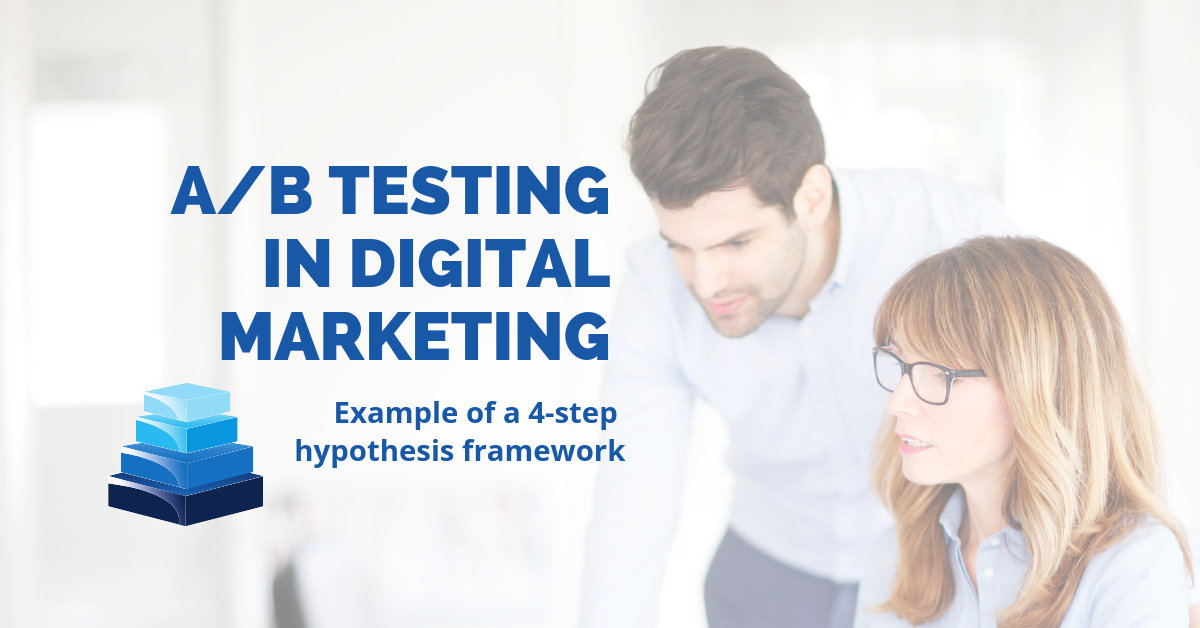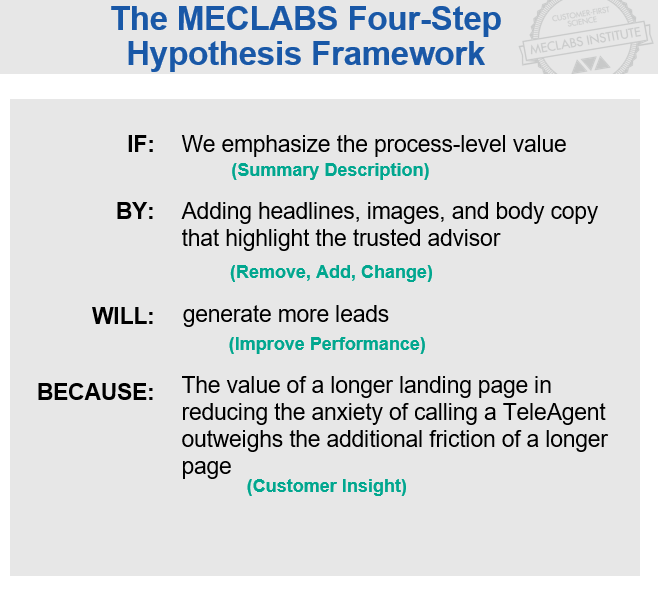
|
SUMMARY:
The more accurate your customer insights, the more impressive your marketing results. We’ve written today’s MarketingSherpa article to help you improve those customers insights. Read on for a hypothesis example we created to answer a question a MarketingSherpa reader emailed us.
|
by Daniel Burstein, Senior Director, Content & Marketing, MarketingSherpa and MECLABS Institute

This article was originally published in the MarketingSherpa email newsletter.
If you are a marketing expert — whether in a brand’s marketing department or at an advertising agency — you may feel the need to be absolutely sure in an unsure world.
What should the headline be? What images should we use? Is this strategy correct? Will customers value this promo?
This is the stuff you’re paid to know. So you may feel like you must boldly proclaim your confident opinion.
But you can’t predict the future with 100% accuracy. You can’t know with absolute certainty how humans will behave. And let’s face it, even as marketing experts we’re occasionally wrong.
Doubt.
It’s not bad, it’s healthy. And the most effective way to overcome that doubt is by testing our marketing creative to see what really works.
Developing a hypothesis
After we published Value Sequencing: A step-by-step examination of a landing page that generated 638% more conversions, a MarketingSherpa reader emailed us and asked …
Great stuff Daniel. Much appreciated. I can see you addressing all the issues there.
I thought I saw one more opportunity to expand on what you made. Would you consider adding the IF, BY, WILL, BECAUSE to the control/treatment sections so we can see what psychology you were addressing so we know how to create the hypothesis to learn from what the customer is currently doing and why and then form a test to address that? The video today on customer theory was great (Editor’s Note: Part of the MarketingExperiments YouTube Live series). I think there is a way to incorporate that customer theory thinking into this article to take it even further.
Developing a hypothesis is an essential part of marketing experimentation. Qualitative-based research should inform hypotheses that you test with real-world behavior.
The hypotheses help you discover how accurate those insights from qualitative research are. If you engage in hypothesis-driven testing, then you ensure your tests are strategic (not just based on a random idea) and built in a way that enables you to learn more and more about the customer with each test.
And that methodology will ultimately lead to greater and greater lifts over time, instead of a scattershot approach where sometimes you get a lift and sometimes you don’t, but you never really know why.
Here is a handy tool to help you in developing hypotheses — the MECLABS Four-Step Hypothesis Framework.
As the reader suggests, I will use the landing page test referenced in the previous article as an example. (Please note: While the experiment in that article was created with a hypothesis-driven approach, this specific four-step framework is fairly new and was not in common use by the MECLABS team at that time, so I have created this specific example after the test was developed based on what I see in the test).
Here is what the hypothesis would look like for that test, and then we’ll break down each part individually:
If we emphasize the process-level value by adding headlines, images and body copy, we will generate more leads because the value of a longer landing page in reducing the anxiety of calling a TeleAgent outweighs the additional friction of a longer page.

IF: Summary description
The hypothesis begins with an overall statement about what you are trying to do in the experiment. In this case, the experiment is trying to emphasize the process-level value proposition (one of the four essential levels of value proposition) of having a phone call with a TeleAgent.
The control landing page was emphasizing the primary value proposition of the brand itself.
The treatment landing page is essentially trying to answer this value proposition question: If I am your ideal customer, why should I call a TeleAgent rather than take any other action to learn more about my Medicare options?
The control landing page was asking a much bigger question that customers weren’t ready to say “yes” to yet, and it was overlooking the anxiety inherent in getting on a phone call with someone who might try to sell you something: If I am your ideal customer, why should I buy from your company instead of any other company.
This step answers WHAT you are trying to do.
BY: Remove, add, change
The next step answers HOW you are going to do it.
As Flint McGlaughlin, CEO and Managing Director of MECLABS Institute teaches, there are only three ways to improve performance: removing, adding or changing.
In this case, the team focused mostly on adding — adding headlines, images and body copy that highlighted the TeleAgents as trusted advisors.
“Adding” can be counterintuitive for many marketers. The team’s original landing page was short. Conventional wisdom says customers won’t read long landing pages. When I’m presenting to a group of marketers, I’ll put a short and long landing page on a slide and ask which page they think achieved better results.
Invariably I will hear, “Oh, the shorter page. I would never read something that long.”
That first-person statement is a mistake. Your marketing creative should not be based on “I” — the marketer. It should be based on “they” — the customer.
Most importantly, you need to focus on the customer at a specific point in time — when he or she is in the mindspace of considering to take an action like purchase a product or in need of more information before they decide to download a whitepaper. And sometimes in these situations, longer landing pages perform better.
In the case of this landing page, even the customer may not necessarily favor a long landing page all the time. But in the real-world situation when they are considering whether to call a TeleAgent or not, the added value helps more customers decide to take the action.
WILL: Improve performance
This is your KPI (key performance indicator). This step answers another HOW question: How do you know your hypothesis has been supported or refuted?
You can choose secondary metrics to monitor during your test as well. This might help you interpret the customer behavior observed in the test.
But ultimately, the hypothesis should rest on a single metric.
For this test, the goal was to generate more leads. And the treatment did — 638% more leads.
BECAUSE: Customer insight
This last step answers a WHY question — why did the customers act this way?
This helps you determine what you can learn about customers based on the actions observed in the experiment.
This is ultimately why you test. To learn about the customer and continually refine your company’s customer theory.
In this case, the team theorized that the value of a longer landing page in reducing the anxiety of calling a TeleAgent outweighs the additional friction of a longer landing page.
And the test results support that hypothesis.
Related Resources
The Hypothesis and the Modern-Day Marketer
Boost your Conversion Rate with a MECLABS Quick Win Intensive
Get Better Business Results With a Skillfully Applied Customer-first Marketing Strategy

The customer-first approach of MarketingSherpa’s agency services can help you build the most effective strategy to serve customers and improve results, and then implement it across every customer touchpoint.
Get More Info >MECLABS AI

Get headlines, value prop, competitive analysis, and more.
Use the AI for FREE (for now) >Marketer Vs Machine

Marketer Vs Machine: We need to train the marketer to train the machine.
Watch Now >Live, Interactive Event

Join Flint McGlaughlin for Design Your Offer on May 22nd at 1 pm ET. You’ll learn proven strategies that drive real business results.
Get Your Scholarship >Free Marketing Course

Become a Marketer-Philosopher: Create and optimize high-converting webpages (with this free online marketing course)
See Course >Project and Ideas Pitch Template

A free template to help you win approval for your proposed projects and campaigns
Get the Template >Six Quick CTA checklists

These CTA checklists are specifically designed for your team — something practical to hold up against your CTAs to help the time-pressed marketer quickly consider the customer psychology of your “asks” and how you can improve them.
Get the Checklists >Infographic: How to Create a Model of Your Customer’s Mind

You need a repeatable methodology focused on building your organization’s customer wisdom throughout your campaigns and websites. This infographic can get you started.
Get the Infographic >Infographic: 21 Psychological Elements that Power Effective Web Design

To build an effective page from scratch, you need to begin with the psychology of your customer. This infographic can get you started.
Get the Infographic >Receive the latest case studies and data on email, lead gen, and social media along with MarketingSherpa updates and promotions.